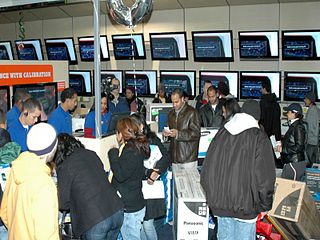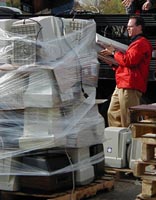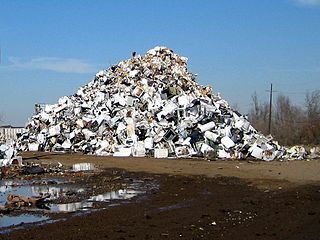
Recycling is the process of converting waste materials into new materials and objects. This concept often includes the recovery of energy from waste materials. The recyclability of a material depends on its ability to reacquire the properties it had in its original state. It is an alternative to "conventional" waste disposal that can save material and help lower greenhouse gas emissions. It can also prevent the waste of potentially useful materials and reduce the consumption of fresh raw materials, reducing energy use, air pollution and water pollution.

Consumer electronics or home electronics are electronic equipment intended for everyday use, typically in private homes. Consumer electronics include devices used for entertainment, communications and recreation. Usually referred to as black goods due to many products being housed in black or dark casings. This term is used to distinguish them from "white goods" which are meant for housekeeping tasks, such as washing machines and refrigerators, although nowadays, these would be considered black goods, some of these being connected to the Internet. In British English, they are often called brown goods by producers and sellers. In the 2010s, this distinction is absent in large big box consumer electronics stores, which sell entertainment, communication and home office devices, light fixtures and appliances, including the bathroom type.

Extended producer responsibility (EPR) is a strategy to add all of the estimated environmental costs associated with a product throughout the product life cycle to the market price of that product, contemporarily mainly applied in the field of waste management. Such societal costs are typically externalities to market mechanisms, with a common example being the impact of cars.

Electronic waste recycling, electronics recycling ore-waste recycling is the disassembly and separation of components and raw materials of waste electronics; when referring to specific types of e-waste, the terms like computer recycling or mobile phone recycling may be used. Like other waste streams, re-use, donation and repair are common sustainable ways to dispose of IT waste.

Ticket resale is the act of reselling tickets for admission to events. Tickets are bought from licensed sellers and then sold for a price determined by the individual or company in possession of the tickets. Tickets sold through secondary sources may be sold for less or more than their face value depending on demand, which tends to vary as the event date approaches. When the supply of tickets for a given event available through authorized ticket sellers is depleted, the event is considered "sold out", generally increasing the market value for any tickets on offer through secondary sellers. Ticket resale is common in both sporting and musical events.
An Electronic Waste Recycling Fee is a fee imposed by government on new purchases of electronic products. The fees are used to pay for the future recycling of these products, as many contain hazardous materials. Locations that have such fees include the European Union, the US State of California and the province of Ontario, Canada.

Electronic waste or e-waste describes discarded electrical or electronic devices. It is also commonly known as waste electrical and electronic equipment (WEEE) or end-of-life (EOL) electronics. Used electronics which are destined for refurbishment, reuse, resale, salvage recycling through material recovery, or disposal are also considered e-waste. Informal processing of e-waste in developing countries can lead to adverse human health effects and environmental pollution. The growing consumption of electronic goods due to the digital revolution and innovations in science and technology, such as bitcoin, has led to a global e-waste problem and hazard. The rapid exponential increase of e-waste is due to frequent new model releases and unnecessary purchases of electrical and electronic equipment (EEE), short innovation cycles and low recycling rates, and a drop in the average life span of computers.
Green market products are previously owned products that have been previously used and put back into productive use. These products are often repaired, refurbished and recycled by brokers, resellers or the original manufacturer. They are suitable for resale to customers as a lower cost alternative to buying new goods from standard distribution channels.

eDay was a New Zealand initiative to hold an annual ewaste collection day, started as Computer Access New Zealand (CANZ) to raise awareness of the potential dangers associated with electronic waste and to offer the opportunity for such waste to be disposed of in an environmentally friendly fashion.

Computer hardware includes the physical parts of a computer, such as the case, central processing unit (CPU), random access memory (RAM), monitor, mouse, keyboard, computer data storage, graphics card, sound card, speakers and motherboard.

Electronic waste or e-waste in the United States refers to electronic products that have reached the end of their operable lives, and the United States is beginning to address its waste problems with regulations at a state and federal level. Used electronics are the quickest-growing source of waste and can have serious health impacts. The United States is the world leader in producing the most e-waste, followed closely by China; both countries domestically recycle and export e-waste. Only recently has the United States begun to make an effort to start regulating where e-waste goes and how it is disposed of. There is also an economic factor that has an effect on where and how e-waste is disposed of. Electronics are the primary users of precious and special metals, retrieving those metals from electronics can be viewed as important as raw metals may become more scarce

Electronic waste is a significant part of today's global, post-consumer waste stream. Efforts are being made to recycle and reduce this waste.

Mobile phone recycling describes the waste management of mobile phones, to retrieve materials used in their manufacture. Rapid technology change, low initial cost, and planned obsolescence have resulted in a fast-growing surplus, which contributes to the increasing amount of electronic waste around the globe.

Electronic waste in New Zealand is an environmental issue being addressed by community and government initiatives.
Recommerce or reverse commerce is the selling of previously owned, new or used products, mainly electronic devices or media such as books, through physical or online distribution channels to buyers who repair, if necessary, then reuse, recycle or resell them.

NextWorth Solutions, Inc., was an electronics trade-in and recycling service. Users of the service exchange used electronics for cash or discounts on newer models. NextWorth was founded by business students at Babson College in 2005. It started as a commission-based service to help businesses setup online auctions for their used items, then changed its business model to focus on electronics trade-ins in 2006. As of late 2012, NextWorth was one of the best-known and largest electronics trade-in and recycling services in the United States, although it handles only a small percentage of total trade-in traffic.

Appliance recycling is the process of dismantling scrapped home appliances to recover their parts or materials for reuse. Recycling appliances for their original or other purposes, involves disassembly, removal of hazardous components and destruction of the equipment to recover materials, generally by shredding, sorting and grading. The rate at which appliances are discarded has increased due in part to obsolescence due to technological advancement, and in part to not being designed to be repairable. The main types of appliances that are recycled are televisions, refrigerators, air conditioners, washing machines, and computers. When appliances are recycled, they can be looked upon as a valuable resources; if disposed of improperly, they can be environmentally harmful and poison ecosystems.

Clifford Eric Lundgren is an American social entrepreneur, innovator and advocate best known for recycling electronic waste. He was the COO of MiningSky and Founder of IT Asset Partners, Inc. (ITAP), an electronics reuse and Hybrid Recycling company. Lundgren served a year in prison after pleading guilty to copying 28,000 Microsoft restore discs that he intended to use in recycled computers.
A take-back system or simply takeback is one of the primary channels of waste collection, especially for e-waste, besides municipal sites. Take-back is the idea that manufacturers and sellers "take back" the products that are at the end of their lives. Take-back is aimed to reduce a business' environmental impacts on the earth and also increase efficiency and lower costs for their business models. "Take-back regulations have targeted a wide array of products including packaging, batteries, automobiles, and electronics" and economic value can be found from recycling or re-manufacturing such products. "The programs benefit municipalities by lowering their overall waste disposal costs and reducing the burden on landfill sites". Although for certain companies, the take-back system is mandatory under legislation, many do it voluntarily.















